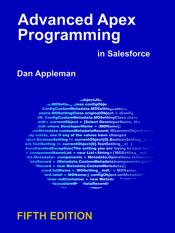I’m pleased to announce the immediate availability of the second edition of Advanced Apex Programming for Saleforce.com and Force.com
A few months ago, when SFDC announced the elimination of script limits, I knew that it had finally happened – a change that really impacted some of the content of the book. That led to some major changes in chapter three. And I figured, as long as I’m working on the book anyway; why not add a few more changes?
Chapter 6 extends the discussion on triggers to clarify some points based on questions I’ve received over the past year.
Chapter 7 has significant new content on batch apex and scheduled apex asynchronous patterns
Chapter 8 is a new chapter on concurrency issues (the later chapters have been renumbered).
Plus, there are numerous other smaller changes and additions scattered throughout the book.
All told, the book has grown by about 50 pages.
It also has a snazzy new cover – making it easy to determine going forward which edition you’re looking at.
Also, unlike last year, I’m pleased to announce that the Kindle and Nook editions are also available for those of you who prefer the eBook format.
The book available now on several Amazon.com country sites, and I’ll be linking the others as they go live. The links on the left will take you to the new edition – it will take a few weeks before all of the channel databases are updated.


Is there a coupon code for first edition buyer?
Well, I’m not sure how one would manage or verify upgrades on books, but if you drop me a note at dan AT desawarepublishing DOT com, I’ll see what I can do 🙂
Great publication. But…
Could an index (online, PDF-Addendum) be developed/provided?
Sigh – yes, I know. A number of people have asked. I didn’t create one in part because I never seem to use indexes in technical books – so I didn’t see them as having that much value. But I’ll definitely consider it going forward.
Thanks Dan for such a wealthy resource..
and your efforts to update it to keep up with the changes in APEX world.. luv ur work..
Hi,
I hope I am missing something in your chapter on packaging strategies.
I created a developer org and got my code working in it.
Then I used Eclipse to push all the components into a new developer org to create the package.
This worked fine and I created a beta package and installed it into a developer org for testing.
The feedback from the testing required some changes to code and custom objects.
So I made the changes in the Code org but when I tried to push them to the package org they failed because my code and custom objects in the package org now had the namespace prefix before the names.
So I created a new developer org for the new package, pushed the code from the code org into it and made a new package.
Of course, this new package had a new namespace prefix, so I couldn’t upgrade my test org – I had to uninstall the original package first.
Am I missing something obvious?
How do I have the set of code org, test org, package org you recommend and avoid the issue with the namespace getting in the way?
Other than this, I love the book – its the only time I have purchased both Ed 1 and 2 of a book.
Sorry about the long delay responding – this comment got caught by a spam filter.
The question is unclear to me. Your developer org should never have a namespace. Pushing code from the developer org via Eclipse or the IDE into a packaging org shouldn’t be a problem. I do it every day. The key thing is never copy/deploy code from an org with a namespace – it only causes headaches. Only copy/deploy code from orgs without a namespace.